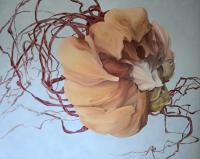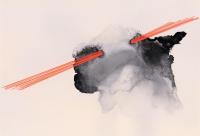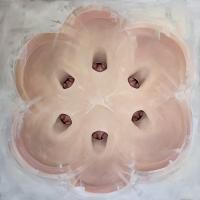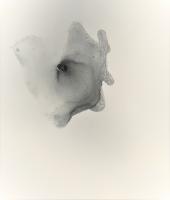I think of my drawings as specimens that have not yet been identified, as in they are abstract organic forms based on textures found in nature with an emphasis on mark making and mapping out larger spaces to find potential areas for detail and elaboration.
My paintings, on the other hand, are inspired from still lifes built from fabrics, toilet paper, foliage, dried flowers and other found objects. Using observational skills to capture every tiny shift in color and temperature, I create an “alien” environment. Scale and color transform the small still life reference to something abstract yet believable, with the resulting space suggesting a home for an organism or life force that is imagined or undiscovered.
Paige Davis is a multimedia artist currently living in Lenexa, KS. She earned her BFA in Visual Art from Clemson University, South Carolina.
Enjoy this exhibition through August 21.
*
What comes first – the medium or the message? Tell me a little about the work that will be on view.
Both! I tend to focus on the medium and, when all goes well, it should enhance the message. I appreciate how oil paints behave and provide so much range in color. For my newer paintings on view, I did a lot of testing with still lifes that involved submerging mundane household objects in milk which added a different layer of depth and created new opportunities with color for me to then play with on canvas to create believable yet abstract environments.
With my multimedia works, I choose my materials with more intent and consideration. A few of my more graphic pieces on view include fly fishing thread which is a nod to my interest in camping and newer hobbies since moving to Kansas - hunting, fishing, and all the skills that you hone while outdoors. When I use graphite and ink, I’m kind of recalling that idea of field notes and studies. I start with an abstract splash of ink, study it and enhance areas of interest. There’s no particular result in mind when I start these pieces, so it’s a bit freeing compared to my oil painting.
What do you feel is your role as an artist?
Recently, I try to focus on how making art enhances my life, personal growth, and critical thinking. In the grander scheme, I hope people that do view my art spend a few moments lost in observation and are able to just be present with the work. Furthermore, I hope it encourages people to make that connection beyond the art - to appreciate the beauty and complexity of their own surroundings.
What influences your practice/works?
I’m inspired by the idea of “place” and observation. Nature continues to be a large influence in my work; moving from SC to TN - and to KS in 2013- has exposed me to a variety of landscapes. In learning about habitats, I was fascinated with the knowledge that there is all this activity at the “edge” of a habitat and its importance. I try to recall that concept when working on a piece.
Who are the other artists you look to for inspiration? And what about their works do you like?
I’m inspired by a lot of portrait painters because I simply love flesh tones and the variety of colors that are actually used to define the figure. From early on, I’ve always enjoyed Jenny Saville’s works and how she places the figure in space and her brush strokes. I’m very much inspired by ceramic artist Sam Davis (he’s also my husband)! He often finds a way to insert humor into his work and is a good reminder not to take myself too seriously or overthink my ideas; he also challenges me to consider context and concept with my work.
What other writings do you recommend reading to have a better understanding of your artworks and your art practice/process? Please look through our on-line catalog and provide any links to resources that you would recommend.
Themes of Contemporary Art: Visual Art after 1980 by Jean Robertson and Craig McDaniel- My painting professor at Clemson introduced us to an excerpt (Chapter 3 in particular regarding “Place”) and it blew my mind.
I also encourage reading any outdoor books that help you identify nature, plants, tracks etc. native to KS (but then go outside and identify stuff and enjoy the feeling of curiosity and discovery)!
This won’t help you understand my work necessarily, but I read a million romance novels. I also find that oil painting in general can be kind of dramatic and romanticized so getting in the studio after reading some angsty love stories makes for good results (especially when paired with an equally dramatic and angsty playlist). Mariana Zapata has been my go-to romance author :)




